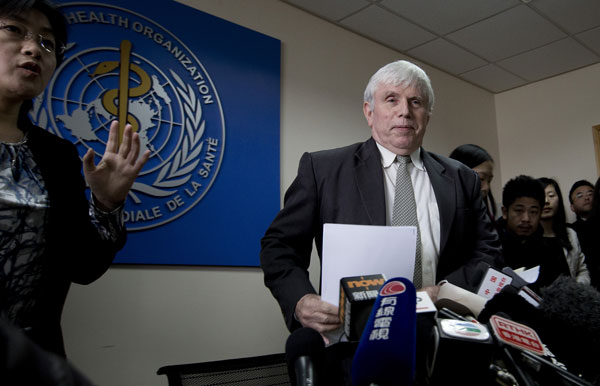H7N9 flu transmission studied
Updated: 2013-04-20 01:54
By Shan Juan (China Daily)
|
|||||||||||
The World Health Organization's China representative said on Friday there are "quite a few" cases in which the many hundreds of people in close contact with H7N9 flu patients fell ill as well.
Such contacts include caregivers, family members and neighbors, said Michael O'Leary.
 |
|
Michael O’Leary, head of the World Health Organization’s office in China, arrives for a media briefing at the WHO office in Beijing on Friday. The organization said there is no evidence that a new strain of bird flu in China is spreading easily among humans. Andy Wong / associated press |
The family cluster involving a father and son both infected with the virus in Shanghai might be a case of one person passing the virus to another — in other words person-to-person transmission, he acknowledged.
It is also possible that both of them were exposed to the same source of infection, he added. "We cannot say for certain and investigations are still going on."
But O'Leary said that even though the virus could spread among humans, transmission would not be easy.
"Otherwise we would see many such cases. We've not seen easy and sustained person-to-person transmission so far," he said.
But he also said it is hard to clearly verify whether it is human-to-human transmission in cases involving close family members.
President Xi Jinping on Friday urged government authorities to take effective measures to contain the spread of the H7N9 avian flu.
Ninty-one human infections have been reported in China so far, resulting in 17 deaths.
The WHO and the Chinese National Health and Family Planning Commission are jointly leading a team of experts at the invitation of China to visit areas affected by the H7N9 virus. They will study the situation and make recommendations for prevention and control of the disease.
The team, comprising 15 international and Chinese experts mainly in epidemiology, laboratory and clinical management, will visit a number of areas in Shanghai and Beijing, O'Leary told a media briefing on Friday. The international experts come from the United States, Europe and Australia.
Early next week, the team is expected to return to Beijing to discuss its findings and make initial recommendations, he said. The findings will be released later by China's top health authority.
"It's a concrete example of international cooperation in action and a demonstration of China's openness in investigating the situation," O'Leary said.
To date, the source of the virus remains unknown, he added.
Evidence suggests that poultry is the vehicle of transmission but epidemiologists have not been able to establish a clear and strong link, which is a major focus of the mission, he said.
However, in no case has the virus been spread through eating poultry that has been cooked properly and which is safe for consumption, O'Leary said.
There have been no positive results from pigs tested for the H7N9 virus.
Related Stories
WHO experts arrive in China for H7N9 assessment 2013-04-19 23:14
H7N9 outbreak troubles bird lovers 2013-04-19 22:46
China works with intl organizations on H7N9 2013-04-19 21:41
2 H7N9 patients discharged from hospitals 2013-04-19 21:16
3 new H7N9 cases reported in E China 2013-04-19 21:16
Beijing farmers to receive H7N9 subsidies 2013-04-19 20:10
Today's Top News
Live report: 7.0-magnitude quake hits Sichuan
Victims' families arrive in Boston
H7N9 flu transmission studied
8% growth predicted for Q2
Nuke reactor gets foreign contract
Boston bombing suspect detained
Boston suspect cornered on boat
First couple on Time's list of most influential
Hot Topics
Lunar probe , China growth forecasts, Emission rules get tougher, China seen through 'colored lens', International board,
Editor's Picks

|

|

|

|

|

|





